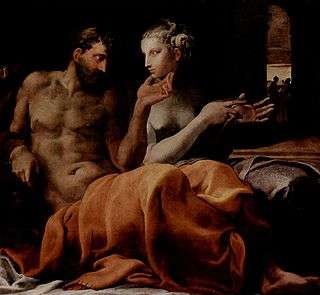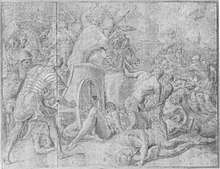Francesco Primaticcio
Francesco Primaticcio (April 30, 1504 – 1570) was an Italian Mannerist painter, architect and sculptor who spent most of his career in France.
_(14803742183).jpg)

Biography
Born in Bologna, he trained under Giulio Romano in Mantua and became a pupil of Innocenzo da Imola, executing decorations at the Palazzo Te before securing a position in the court of Francis I of France in 1532.

Together with Rosso Fiorentino he was one of the leading artists to work at the Chateau Fontainebleau (where he is grouped with the so-called "First School of Fontainebleau") spending much of his life there. Following Rosso's death in 1540, Primaticcio took control of the artistic direction at Fontainebleau, furnishing the painters and stuccators of his team, such as Nicolò dell'Abate, with designs. He made cartoons for tapestry-weavers and, like all 16th-century court artists, was called upon to design elaborate ephemeral decorations for masques and fêtes, which survive only in preparatory drawings and, sometimes, engravings. Francis I trusted his eye and sent him back to Italy on buying trips in 1540 and again in 1545.
In Rome, part of Primaticcio's commission was to take casts of the best Roman sculptures in the papal collections, some of which were cast in bronze to decorate the parterres at Fontainebleau.[1]
Primaticcio retained his position as court painter to Francis' heirs, Henry II and Francis II. His masterpiece, the Salle d'Hercule at Fontainebleau, occupied him and his team from the 1530s to 1559.
Primaticcio's crowded Mannerist compositions and his long-legged canon of beauty influenced French art for the rest of the century.
Primaticcio turned to architecture towards the end of his life, his greatest work being the Valois Chapel at the Abbey of Saint-Denis, although this was not completed until after his death and was destroyed in 1719.
Gallery
 Alexander tames Bucephalus
Alexander tames Bucephalus The rape of Helena, 1530-1539
The rape of Helena, 1530-1539- Ceiling at Chaalis Abbey
- Annunciation at Chaalis
_at_Fontainebleau_MET_MM20346.jpg) Apollo, Pan, and a putto blowing a horn, from a series of eight compositions after Francesco Primaticcio's designs for the ceiling of the Ulysses Gallery (destroyed 1738-39)at Fontainebleau.
Apollo, Pan, and a putto blowing a horn, from a series of eight compositions after Francesco Primaticcio's designs for the ceiling of the Ulysses Gallery (destroyed 1738-39)at Fontainebleau._at_Fontainebleau_MET_DP821337.jpg) Three Muses and a Gesturing Putto, from a series of eight compositions after Francesco Primaticcio's designs for the ceiling of the Ulysses Gallery (destroyed 1738-39) at Fontainebleau
Three Muses and a Gesturing Putto, from a series of eight compositions after Francesco Primaticcio's designs for the ceiling of the Ulysses Gallery (destroyed 1738-39) at Fontainebleau_at_Fontainebleau_MET_DP821276.jpg) Three Muses and a Putto with a Lyre, a cruciform composition, from a series of eight compositions after Francesco Primaticcio's designs for the ceiling of the Gallery of Ulysses (destroyed 1738-39) at Fontainebleau
Three Muses and a Putto with a Lyre, a cruciform composition, from a series of eight compositions after Francesco Primaticcio's designs for the ceiling of the Gallery of Ulysses (destroyed 1738-39) at Fontainebleau_at_Fontainebleau_MET_DP821339.jpg) Three Muses and a Putto with Cymbals, from a series of eight compositions after Francesco Primaticcio's designs for the ceiling of the Ulysses Gallery (destroyed 1738-39) at Fontainebleau
Three Muses and a Putto with Cymbals, from a series of eight compositions after Francesco Primaticcio's designs for the ceiling of the Ulysses Gallery (destroyed 1738-39) at Fontainebleau
%2C_from_a_series_of_eight_compositions_after_Francesco_Primaticcio's_designs_for_the_ceiling_of_the_Ulysses_Gallery_(destroyed_1738-39)_at_Fontainebleau_MET_DP821346.jpg) Hercules, Bacchus, Pan, and Saturn(?), from a series of eight compositions after Francesco Primaticcio's designs for the ceiling of the Ulysses Gallery (destroyed 1738-39) at Fontainebleau
Hercules, Bacchus, Pan, and Saturn(?), from a series of eight compositions after Francesco Primaticcio's designs for the ceiling of the Ulysses Gallery (destroyed 1738-39) at Fontainebleau_at_Fontainebleau_MET_DP821331.jpg) Ceres Seated on Clouds with Two Goddesses and Two Putti, from a series of eight compositions after Francesco Primaticcio's designs for the ceiling of the Ulysses Gallery (destroyed 1738-39) at Fontainebleau
Ceres Seated on Clouds with Two Goddesses and Two Putti, from a series of eight compositions after Francesco Primaticcio's designs for the ceiling of the Ulysses Gallery (destroyed 1738-39) at Fontainebleau_at_Fontainebleau_MET_DP821333.jpg) Pluto, Neptune, Minerva and Apollo, from a series of eight compositions after Francesco Primaticcio's designs for the ceiling of the Ulysses Gallery (destroyed 1738-39) at Fontainebleau
Pluto, Neptune, Minerva and Apollo, from a series of eight compositions after Francesco Primaticcio's designs for the ceiling of the Ulysses Gallery (destroyed 1738-39) at Fontainebleau_at_Fontainebleau_MET_DP821328.jpg) Venus and Cupid, Two Other Goddesses, and a Putto, from a series of eight compositions after Francesco Primaticcio's designs for the ceiling of the Ulysses Gallery (destroyed 1738-39) at Fontainebleau
Venus and Cupid, Two Other Goddesses, and a Putto, from a series of eight compositions after Francesco Primaticcio's designs for the ceiling of the Ulysses Gallery (destroyed 1738-39) at Fontainebleau Ulysses and His Companions Fighting the Cicones Before the City of Ismaros, Study for a Destroyed Fresco in the Galerie d'Ulysee, Chateau de Fontainebleau
Ulysses and His Companions Fighting the Cicones Before the City of Ismaros, Study for a Destroyed Fresco in the Galerie d'Ulysee, Chateau de Fontainebleau
Notes
- The project, which brought a first virtual confrontation with Roman sculpture to French patrons and artists, is surveyed in detail by S. Pressouyre, "Les fontes de Primatice à Fontainebleau", Bulletin monumental 127 (1969), pp. 223-38. See also Thomas Clouet, "Fontainebleau de 1541 à 1547. Pour une relecture des Comptes des Bâtiments du roi", Bulletin monumental 170 (2012), pp. 195-234, in which article a precise chronology of the casting of these famous bronzes is established (english summary). The precious moulds, at the instigation of Leone Leoni were sent to the Habsburg court in the Spanish Netherland in 1550 and, after serving to make a set of stucco casts for Charles V's daughter Mary of Hungary, Queen-governess of the Netherlands at Binche (where they were destroyed by Henry II's troops in 1554) they were probably forwarded to Leoni in Milan (Bruce Boucher, "Leone Leoni and Primaticcio's Moulds of Antique Sculpture", The Burlington Magazine 123 No. 934 (January 1981), pp. 23-26).
References
The Oxford Dictionary of Art, ISBN 0-19-280022-1
| Wikimedia Commons has media related to Francesco Primaticcio. |
External links
- Entry in 'Art-cyclopedia'
- Château de Fontainebleau (in English)
- The engravings of Giorgio Ghisi, a full text exhibition catalog from The Metropolitan Museum of Art, which contains material on Francesco Primaticcio (see index)